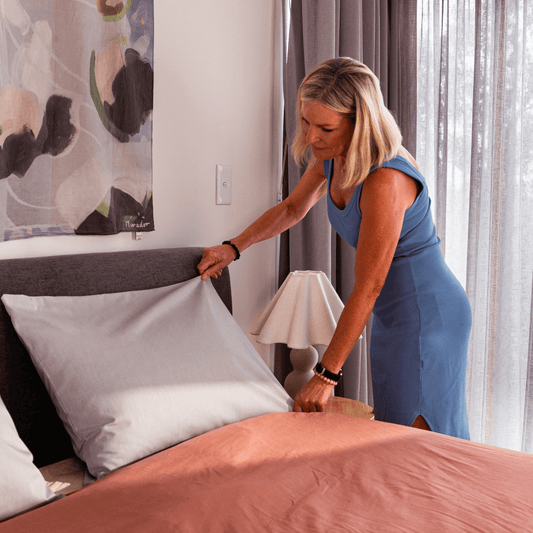
How Grounding Boosts Your Circulation as Explained by Science
Denzel SueltoGood circulation is important for your overall health. It helps deliver oxygen and nutrients to your body while removing waste.
But if your blood flow isn’t great, you might experience cold hands and feet, numbness, swelling, or fatigue.
But one simple and often overlooked method is grounding—connecting your body directly to the Earth.
In this guide, we’ll go over how grounding works, what the science says, and the best ways to do it for better circulation.
Key Takeaways
- Grounding (earthing) improves circulation by balancing the body’s electrical charge.
- It helps thin the blood naturally, which reduces clumping and enhances oxygen flow.
- Better circulation supports cardiovascular health and reduces the risk of blood-related conditions.
- Grounding can decrease inflammation, which otherwise restricts blood flow.
- Both outdoor grounding and grounding products can deliver circulation benefits.
- People with blood-thinning medications should consult a doctor before grounding regularly.
- Scientific studies suggest grounding improves heart rate variability and blood viscosity.
How Does Grounding Affect Blood Circulation?
Grounding, or earthing, involves direct physical contact with the Earth's surface, such as walking barefoot outdoors.
This practice is believed to influence blood circulation by affecting the electrical charge of red blood cells (RBCs).
A study found that grounding increased the zeta potential of RBCs by an average of 2.70 millivolts, reducing blood viscosity and clumping. This suggests that grounding may enhance overall blood flow.
Additionally, another research demonstrated that just one hour of grounding significantly improved facial blood flow regulation, indicating potential benefits for skin tissue repair and appearance.
Why is Poor Circulation a Problem?
Poor circulation means that certain body parts aren't getting enough blood flow, which can lead to serious health issues.
Common causes include conditions like diabetes, peripheral artery disease (PAD), and Raynaud’s phenomenon.
Even lifestyle factors, such as smoking and sitting for long hours, can contribute to restricted blood flow.
Signs of Poor Circulation
- Muscle cramps and pain – Aching or weakness in the legs, especially when walking.
- Numbness and tingling – A “pins and needles” sensation, mostly in the hands and feet.
- Cold extremities – Hands and feet may feel unusually cold compared to the rest of the body.
- Swelling – Fluid buildup, particularly in the lower legs and ankles.
- Skin changes – Pale or bluish skin, and sometimes varicose veins.
Ignoring these symptoms can lead to serious complications.
If blood flow is severely restricted, wounds take longer to heal, infections become more likely, and nerve damage or dangerous blood clots can occur in extreme cases.
How Can You Use Grounding for Better Circulation?
Grounding is one of the easiest ways to support better blood flow, and the best part is that it doesn’t require much effort!
Here are some simple ways to do it:
1. Walk Barefoot Outside
Walking barefoot on grass, sand, or soil lets your body absorb the Earth’s natural energy.
It’s the most natural form of grounding and may help improve circulation over time. Try spending at least 30 minutes a day walking or standing barefoot outside.
And yes, it's free of charge!
2. Use a Grounding Mat or Sheet
If going outside isn’t an option, our grounding mats and grounding sheets are a great alternative.
They’re designed to mimic direct contact with the Earth and can be used while working, relaxing, or sleeping.
Even better, we also have grounding pillowcases and mouse pads for your office!
3. Spend Time Sitting or Lying on the Ground
Something as simple as sitting on the grass or lying on the beach can help your body connect with the Earth.
Gardening is another great way to ground yourself—your hands are in direct contact with the soil, which may provide similar benefits.
4. Move While Grounding
Light movement, like stretching, yoga, or even a slow walk while grounded, can boost circulation even more.
Exercise already helps blood flow, and doing it barefoot on natural surfaces may enhance the effect.
Tips to Make Grounding More Effective:
- Be consistent. The more often you ground, the better. Try to do it daily.
- Stay grounded for at least 30 minutes. This gives your body enough time to absorb the Earth’s energy.
- Choose the right surfaces. Grass, sand, soil, and concrete (if not sealed) work best. Asphalt and wood won’t conduct the same way.
Grounding is an easy, natural way to support better circulation without extra effort.
Just take off your shoes, connect with the Earth, and let your body do the rest!
Frequently Asked Questions
-
How does grounding improve circulation?
Grounding balances your body’s electrical state, helping blood flow more smoothly and reducing clotting. -
Can grounding thin the blood naturally?
Yes, research suggests grounding can reduce blood viscosity, making it easier for blood to circulate. -
Is grounding good for heart health?
Yes, improved circulation supports cardiovascular function, lowers strain on the heart, and may reduce heart risks. -
Can grounding reduce high blood pressure?
Some studies suggest grounding can help regulate blood pressure, though results vary. -
Does grounding reduce inflammation in blood vessels?
Yes, grounding has been shown to lower inflammation markers, which improves circulation. -
What are the signs of poor circulation that grounding can help with?
Cold hands/feet, fatigue, and sluggish recovery may improve with better blood flow. -
Is grounding safe for people on blood thinners?
Consult a doctor first, since grounding may naturally thin the blood. -
Can grounding help with varicose veins or swelling?
Yes, by improving circulation and reducing inflammation, grounding may ease these conditions. -
How long does it take to see circulation benefits from grounding?
Some people report results in days to weeks of consistent practice. -
Do grounding mats improve circulation like outdoor grounding?
Yes, high-quality grounding mats can provide similar benefits when connected to Earth’s energy. -
Is grounding safe during exercise for circulation?
Yes, grounding before or after workouts may enhance recovery and reduce inflammation. -
Does grounding improve oxygen delivery in the body?
Yes, smoother blood flow improves oxygen transport to tissues and organs.
References
Chevalier, G. (2014). Grounding the human body improves facial blood flow regulation: Results of a randomized, placebo controlled pilot study. Journal of Cosmetics, Dermatological Sciences and Applications, 4(5), 293–308. doi:10.4236/jcdsa.2014.45039
Chevalier, G., Melvin, G., & Barsotti, T. (2015). One-hour contact with the Earth’s surface (grounding) improves inflammation and blood flow: A randomized, double-blind, pilot study. Health, 7(8), 1022–1059. doi:10.4236/health.2015.78119
Chevalier, G., Sinatra, S. T., Oschman, J. L., & Delany, R. M. (2013). Earthing (grounding) the human body reduces blood viscosity—A major factor in cardiovascular disease. Journal of Alternative and Complementary Medicine, 19(2), 102–110. doi:10.1089/acm.2011.0820
Sokal, K., & Sokal, P. (2011). Earthing the human body influences physiologic processes. Journal of Alternative and Complementary Medicine, 17(4), 301–308. doi:10.1089/acm.2010.0687










